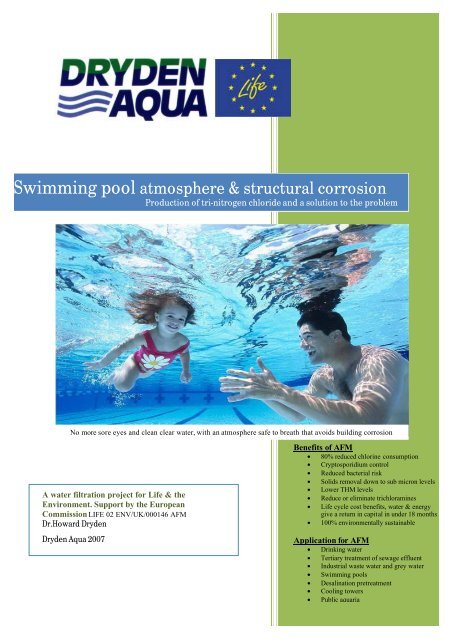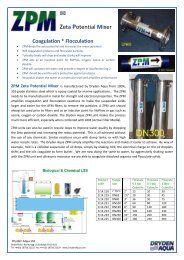Swimming pool atmosphere & structural corrosion
Swimming pool atmosphere & structural corrosion
Swimming pool atmosphere & structural corrosion
You also want an ePaper? Increase the reach of your titles
YUMPU automatically turns print PDFs into web optimized ePapers that Google loves.
<strong>Swimming</strong> <strong>pool</strong> <strong>atmosphere</strong> & <strong>structural</strong> <strong>corrosion</strong><br />
Production of tri-nitrogen chloride and a solution to the problem<br />
No more sore eyes and clean clear water, with an <strong>atmosphere</strong> safe to breath that avoids building <strong>corrosion</strong><br />
A water filtration project for Life & the<br />
Environment. Support by the European<br />
Commission LIFE 02 ENV/UK/000146 AFM<br />
Dr.Howard Dryden<br />
Dryden Aqua 2007<br />
Benefits of AFM<br />
• 80% reduced chlorine consumption<br />
• Cryptosporidium control<br />
• Reduced bacterial risk<br />
• Solids removal down to sub micron levels<br />
• Lower THM levels<br />
• Reduce or eliminate trichloramines<br />
• Life cycle cost benefits, water & energy<br />
give a return in capital in under 18 months<br />
• 100% environmentally sustainable<br />
Application for AFM<br />
• Drinking water<br />
• Tertiary treatment of sewage effluent<br />
• Industrial waste water and grey water<br />
• <strong>Swimming</strong> <strong>pool</strong>s<br />
• Desalination pretreatment<br />
• Cooling towers<br />
• Public aquaria
No more sore eyes and clean clear water, with an <strong>atmosphere</strong> safe to breath that avoids building <strong>corrosion</strong><br />
<strong>Swimming</strong> <strong>pool</strong> air quality & <strong>structural</strong> <strong>corrosion</strong> of the building<br />
The <strong>atmosphere</strong> in health clubs and swimming <strong>pool</strong> buildings are amongst the most corrosive<br />
environments for a building structure, especially when stainless steel materials are used. In<br />
1985, 12 people were killed in Uster, Switzerland when the concrete roof of a swimming <strong>pool</strong><br />
collapsed after only thirteen years. The Federal Materials Testing Institute, based in Duebendorf,<br />
Switzerland, and the Federal Materials Research and Testing Institute of Berlin concluded that<br />
the collapse was the result of chlorideinduced<br />
Stress Corrosion Cracking (SCC).<br />
Every year there are serious <strong>structural</strong><br />
failures reported for European for<br />
swimming <strong>pool</strong> buildings, in addition there<br />
can also be <strong>corrosion</strong> of ducts in HVAC<br />
systems, acid erosion of concrete, damage to<br />
electrical circuits, such as the telephone<br />
system and computers which costs the<br />
industry millions of Euros every year.<br />
The problems are a product of the warm<br />
humid environment with a high<br />
concentration of chloride in the <strong>atmosphere</strong>.<br />
However where does the chloride come from and why is it in the <strong>atmosphere</strong>? These are simple<br />
questions but they have never been properly answered.<br />
When chlorine is added to water, it reacts to form a pH dependent equilibrium solution of<br />
hypochlorous acid hypochlorite ions. However when you enter a swimming <strong>pool</strong> environment<br />
the chemical that gives swimming <strong>pool</strong>s their characteristic smell is not chlorine but a volatile<br />
gas called tri-nitrogen chloride (trichloramine), which is acidic and corrosive. It is likely that<br />
tri-nitrogen chloride is responsible for causing the <strong>structural</strong> problems in swimming <strong>pool</strong>s. Trinitrogen<br />
chloride has also been implicated in causing occupational asthma among <strong>pool</strong> staff, and<br />
lung damage to children attending swimming <strong>pool</strong>s.<br />
Tri-nitrogen chloride is formed by a reaction between chlorine and ammonium under acidic<br />
conditions in the water. Indeed the pH of the water needs to be less than pH 5 for tri-nitrogen<br />
chloride to form. However swimming <strong>pool</strong>s are always maintained at a precise pH between pH<br />
6.8 and 7.6, so how can tri-nitrogen chloride be formed?<br />
Chlorine is a very effective disinfectant which kills most bacteria within a period of 30 seconds<br />
in the water. However when the bacteria are fixed to a surface (biofilm) they become almost<br />
totally resistant to chlorine. If you slide your finger across the surface of the tiles, if it feels<br />
slippy then this is due to a bacterial film. While the pH of the swimming <strong>pool</strong> water is between<br />
6.8 and 7.6, the pH of the micro environment on the surface of the biofilm will be acidic. The<br />
principle location for the production of tri-nitrogen chloride is therefore on the surface of the<br />
biofilm.<br />
The <strong>pool</strong> surfaces, tiles, and pipe work have a high surface area, all of which will be coated by a<br />
bacterial layer, but by far the largest surface area in contact with the water is the sand in the<br />
sand filters. One metric tonne of sand has a surface area of approximately 3000 square meters.<br />
In a standard 25m <strong>pool</strong> there will be in the region of 20 tonnes of sand which gives a surface<br />
area of 60,000 square meters. Tri-nitrogen chloride formation therefore occurs predominantly<br />
on the sand inside the sand filters.<br />
Dryden Aqua Ltd | Butlerfield | Bonnyrigg | Edinburgh EH19 3KQ | Scotland UK |<br />
Tel +44 (0) 18758 22222 Fax +44 (0) 18748 22229 www.AFM.eu<br />
LIFE 02 ENV/UK/000146 AFM<br />
2
No more sore eyes and clean clear water, with an <strong>atmosphere</strong> safe to breath that avoids building <strong>corrosion</strong><br />
If a swimming <strong>pool</strong> is designed properly with a good filtration system in accordance to the<br />
German DIN standards, and operated at the correct water flow rate, the water quality and<br />
atmospheric air quality will be greatly improved. The use of ozone systems and UV irradiation<br />
will improve water quality but both processes generate volatile chlorine reaction products<br />
which affect air quality. Water quality is important, but the air quality is even more important<br />
for the building, and from a public health perspective. It is therefore recommended that UV<br />
irradiation and ozone systems are not used in chlorinated systems.<br />
The production of tri-nitrogen chloride is directly related to the surface area in contact with the<br />
water and the degree of biofouling on the surfaces, so if you eliminate the bacteria you eliminate<br />
the problem. Good hygiene is essential to control bacteria, and every effort should be taken to<br />
minimise the introduction of bacterial food, such as phosphates which can enter via the mains<br />
freshwater supply. Chemicals used in <strong>pool</strong> treatment can also contain phosphates. Surfactants<br />
used by the <strong>pool</strong> staff for cleaning the side of the <strong>pool</strong> represent another source of phosphates.<br />
The choice of chemical products and the cleaning regime should be chosen with care, and under<br />
no circumstances should cleaning chemicals containing anionic surfactants and phosphates be<br />
allowed to enter the water. It is also essential that the public shower before entering the <strong>pool</strong>,<br />
preferably without the use of shampoo or soap. Indeed the building should be designed such<br />
that it is impossible for the public to avoid the showers before entering the <strong>pool</strong>.<br />
The recent appreciation of the role bacteria play in the production of the corrosive volatile gas<br />
tri-nitrogen chloride has led to the development of new technology. Filtration media designed to<br />
replace sand in sand filters has been developed that rejects bacterial growth. One such media is<br />
Active Filter Media (AFM). When biostatic media is used in place of the sand the biomass of<br />
bacteria is greatly reduced, and thereby the production of tri-nitrogen chloride is reduced.<br />
Products that remove phosphate and bacterial nutrients, (NoPhos) and dissolved organic matter<br />
(PAC) should be injected into the water prior to the AFM filters. These products coagulate<br />
dissolved bacterial nutrients, and then flocculate the coagulated particles into larger particles<br />
which makes it easier for the filters to remove. The role of coagulation and flocculation is<br />
therefore absolutely essential in swimming <strong>pool</strong> systems to maintain both water and air quality.<br />
Diatomaceous and perilite filters are being considered for use in swimming <strong>pool</strong> water<br />
treatment systems. While the filters are very effective at removing solids from the water,<br />
coagulation and flocculation chemicals can not be used because the chemicals rapidly block the<br />
filters. Coagulation and flocculation can be used with AFM filters, but over the last 30 years the<br />
average velocity of the water through media filters has been increased from 15m/hr to 30m/hr<br />
in an effort to save costs and space in the plant rooms. Media bed filtration performance varies<br />
inversely proportionally to the water flow rate, and at the higher water flows coagulation and<br />
flocculation chemicals are not as effective. It is therefore important that the water flow rate<br />
through media bed filters is reduced to at least 15m/hr .<br />
The lack of appreciation of the role played by bacterial biofouling has led to some serious flaws<br />
in the design of swimming <strong>pool</strong> water treatment systems over the last 30 years, and this has<br />
caused the problems that we are now experiencing. Building structures are being compromised<br />
and the health of the <strong>pool</strong> staff and public are being affected. However give an understanding of<br />
the mechanism of tri-nitrogen chloride production, the solution to the problem is both elegant<br />
and simple. Slow media bed filtration should be employed using a biostatic filter media such as<br />
AFM, coupled with NoPhos & PAC coagulation and flocculation to reduce bacteria nutrients.<br />
Short cuts should not be taken with the size and quality of the filtration system, and the staff<br />
should be proficient and qualified. By taking these simple measures the water quality will be<br />
optimised and the <strong>atmosphere</strong> will be much safer for the public and the building.<br />
Dryden Aqua Ltd | Butlerfield | Bonnyrigg | Edinburgh EH19 3KQ | Scotland UK |<br />
Tel +44 (0) 18758 22222 Fax +44 (0) 18748 22229 www.AFM.eu<br />
LIFE 02 ENV/UK/000146 AFM<br />
3






